How To Study The Bible
Sometimes extra resources help us uncover more meaning behind what the Bible says. We’ve got history here, plus helpful commentaries from KJV readers of past centuries. Enjoy!
STUDY
The King James Bible
We’ve put together some resources to help you as you dig into your King James Bible. Blogs, commentary and a verse finder will help when you are looking into a particular theme or passage.
“Study to shew thyself approved unto God, a workman that needeth not to be ashamed, rightly dividing the word of truth.” 2 Timothy 3:15
1
Helpful Blog Posts
Whether you are looking for historical background on the KJV, or if you’d like practical advice on approaching Bible study, there are posts to help.
Coming Soon
Matthew Henry’s Commentary
Matthew Henry was a minister in Chester, England during the turn of the 18th century. His beloved 6 volume Complete Commentary contains helpful notes on every verse of the King James Version Bible, and in the same wonderful language.
2
3
Coming Soon
Verses by Topic
Whether you want to know what God’s word says about the future, want to know deeper contentment, or need words of comfort for a friend, you can search for targeted verses.
A Historical Timeline
OF THE KJV BIBLE
The King James Bible was first published in 1611, but has a long, rich history that started much earlier. Explore our timeline to learn about how it was developed from the original manuscripts to its standing in our modern day as an authoritative translation of the Word of God.
-
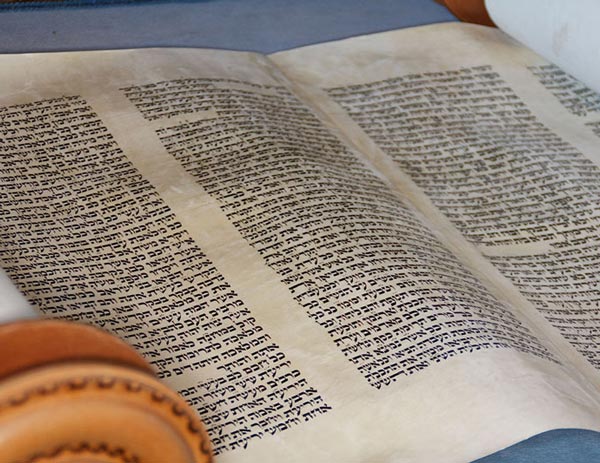 AD 1
AD 1The Hebrew Scriptures
By Jesus’ time, our current Old Testament was compiled in a collection known as the Hebrew Scriptures (e.g., Luke 24:45), commonly referred to as the Law, Prophets, and Writings/Psalms (e.g., Luke 24:44). -
40-95
New Testament Books Written
All 27 books of the New Testament were written over roughly 55 years. The book of James was most likely written first and Revelation last. -
 325-450
325-450The Four Great Codices
The “four great codices” were produced—Codex Vaticanus, Codex Sinaiticus, Codex Alexandrinus, and Codex Ephraemi—which serve as the oldest existing manuscripts to contain the entire Bible. Codex Vaticanus is considered to be the oldest surviving copy of the Bible. -
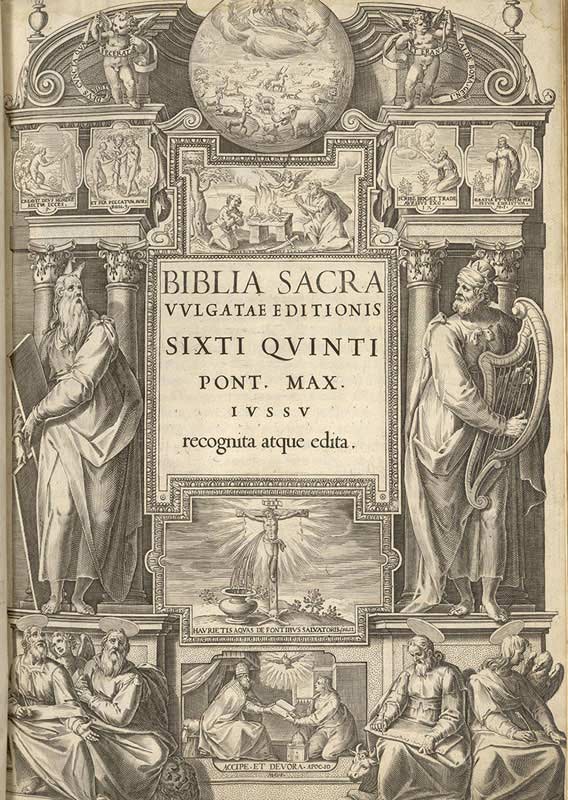 382-405
382-405Latin Vulgate Produced
Early church father Jerome (347-420) completed the Latin translation of the Bible, known as the Vulgate. It dominated Western Christianity for over 1000 years and remained the official Catholic translation of the Bible until the 1960s. -
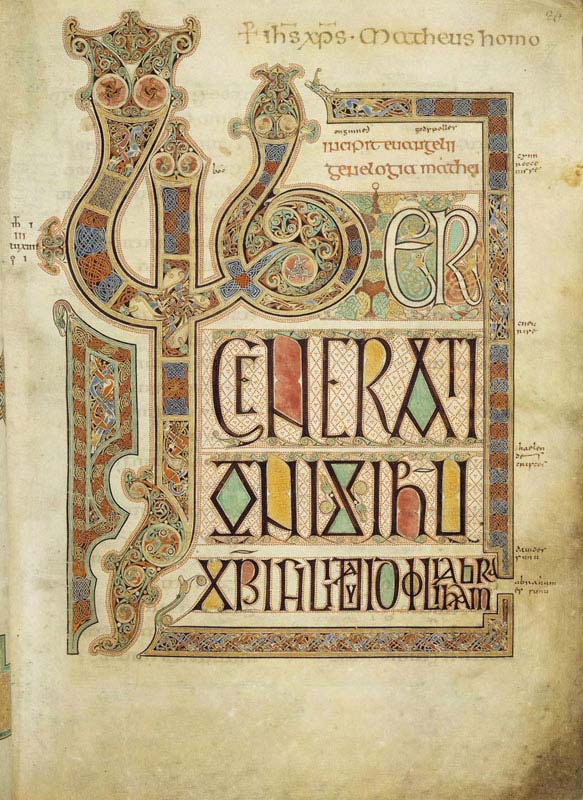 715-720
715-720Lindisfarne Gospels
The most spectacular manuscript to survive Anglo-Saxon England, the Lindisfarne Gospels is an illuminated manuscript containing all four Gospels. Believed to be produced by Eadfrith, a monk on Lindisfarne island off England’s northeast coast, it is written in Old English, the earliest recorded form of English (the language of the epic poem Beowulf). -
800s
Masoretic Text Standardized
Jewish scholars produced the authoritative Hebrew text of the Old Testament, known as the Masoretic Text, between the 7th and 10th centuries. It served as the basis for the Old Testament translations of the King James Version (1611), the American Standard Version (1901), and most modern Bible translations. -
1175
Wessex Gospels
The much less adorned Wessex Gospels (also known as the West-Saxon Gospels), are a translation of the four Gospels into the West Saxon dialect of Old English. Without accompanying Latin, they are the oldest surviving example of stand-alone Old English. -
 1382
1382Wycliffe’s Bible
Driven by the conviction that everyone should have a copy of the Bible in a language they could understand, John Wycliffe (1330-1384) translated the Bible into Middle English (the language of Chaucer. Several decades after his death, Wycliffe was declared a heretic by the Catholic Church, his body exhumed and burned at the stake. -
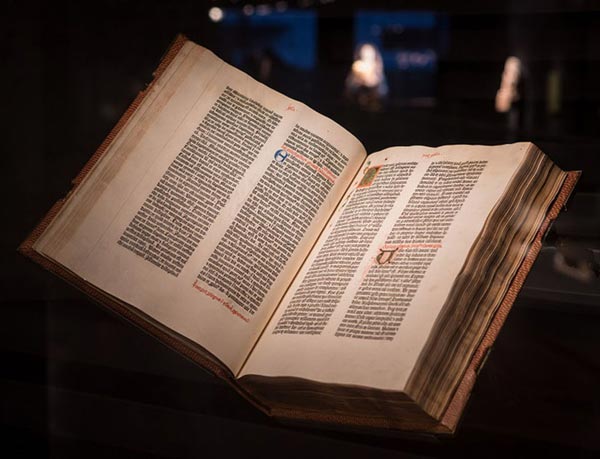 1455
1455The Gutenberg Bible
Using the Latin Vulgate, the first Bible was printed (known as the Gutenberg Bible) using the new technology of Gutenberg’s printing press and revolutionizing Bible production, which previously had been painstakingly done by hand. (Image by Alpra ArazeL, CC BY-SA 4.0, via Wikimedia Commons) -
1516
Textus Receptus
Dutch scholar Erasmus of Rotterdam (1466-1536) published the first Greek New Testament, Novem Instrumentum omne, later known as the Textus Receptus, mainly from 12th and 13th century manuscripts. The Textus Receptus became the foundation for most Protestant Bible translations including Tyndale’s English Bible (1526), Luther’s German New Testament (1522), and the King James Version (1611) -
1525
Mikraot Gedolot (Second Rabbinic Bible)
This updated version of the Masoretic Text, edited by Hebrew scholar Yaakov ben Hayyim, became the source text used by the translators of the King James Version (1611) and New King James Version (1982). -
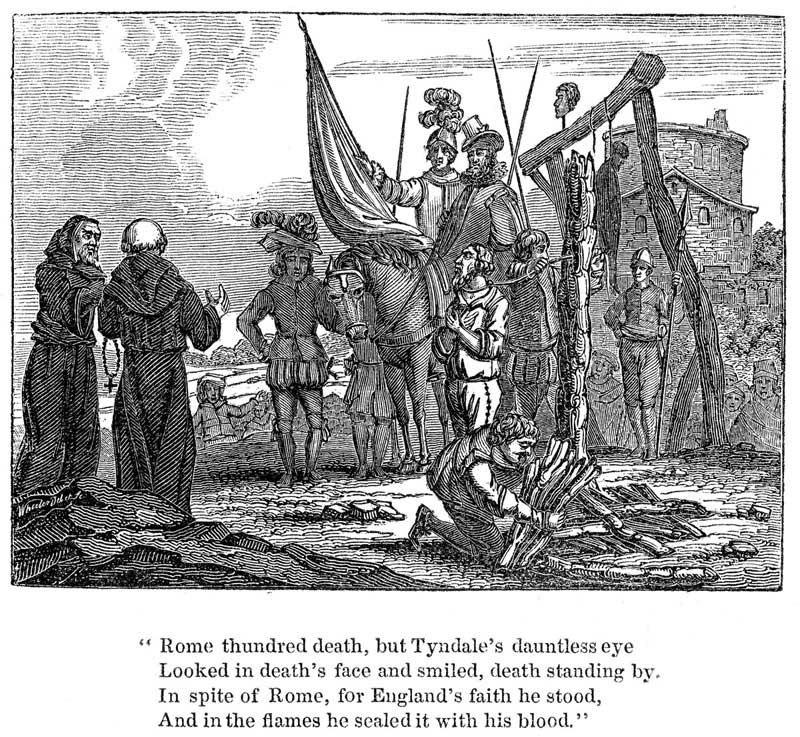 1526
1526Tyndale Bible
William Tyndale (1494-1536) translated the first Modern English Bible (although incomplete) directly from the Hebrew and Greek of the Old and New Testaments. He was executed under the command of Henry VIII for this “crime.” -
1535
The Great Bible
Under the authorization of King Henry VIII, Myles Coverdale (1488-1569) translated the first complete Bible into modern English, known as the Great Bible. The Great Bible remained the official translation authorized by the Church of England until the Bishops’ Bible. However, parts of it were produced from the Latin Vulgate, not the original biblical languages, making it an inferior translation. -
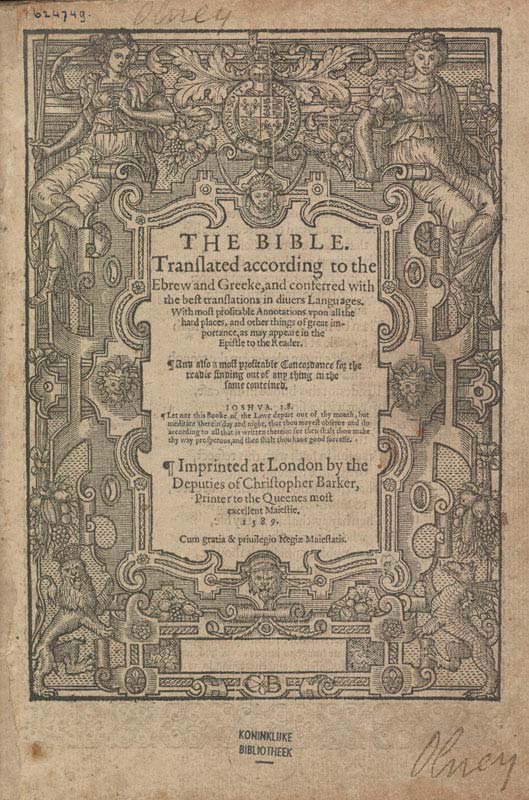 1560
1560Geneva Bible
The first English Bible translation done by committee, the Geneva Bible came with study notes, cross references, and chapter and verse numbers. It was the dominant English Bible translation of the 16th century, used by such famous people as William Shakespeare, John Bunyan (author of Pilgrims Progress), and Oliver Cromwell. It was the main competition for the KJV for about a century. -
1568
Bishops’ Bible
Produced in 1568 during the reign of Queen Elizabeth I, the Bishops’ Bible became the second Bible authorized by the Crown. It was revised in 1572 and again in 1602, this later version being the base text used for the King James Bible. -
1610
Catholic English Bible
During the Catholic “counter-Reformation,” the Roman Catholic Church produced its own English Bible, the Douay-Rheims Bible (named after a college in England and a city in France). Translated directly from the Latin Vulgate, this Bible version was released in stages: the New Testament completed in 1582, and the Old Testament plus Apocrypha published in 1609-1610. It underwent various editions as late as the first decade of the 19th century. -
 1603
1603James Crowned King of England
James IV, king of Scotland, became James I, King of England after Elizabeth I. The following year, James organized a committee to examine and consolidate the various English versions of the Bible into one standard version authorized by the crown, especially as notes in the Geneva Bible undermined the position of the king as head of the church. Seven years later the King James Bible was published. -
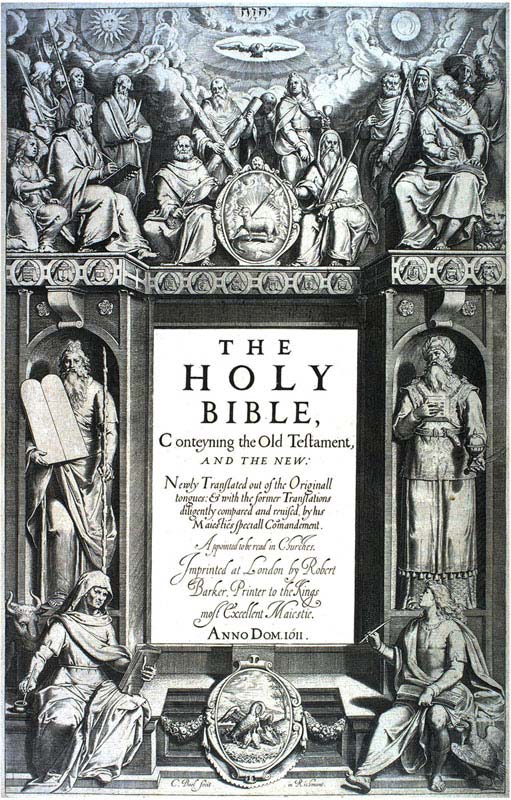 1611
1611King James Version
The third English translation sanctioned by the British monarchy—and subsequently known as the Authorized Version—the King James Version was produced by six committees of roughly fifty men. This translation dominated the English-speaking world for nearly four centuries. -
1769
Blayney’s Edition
After several minor editions of the King James Version were published over the decades, this 4th edition published by Benjamin Blayney in 1769 corrected printing errors and updated spelling. It is the edition current printings are based upon. -
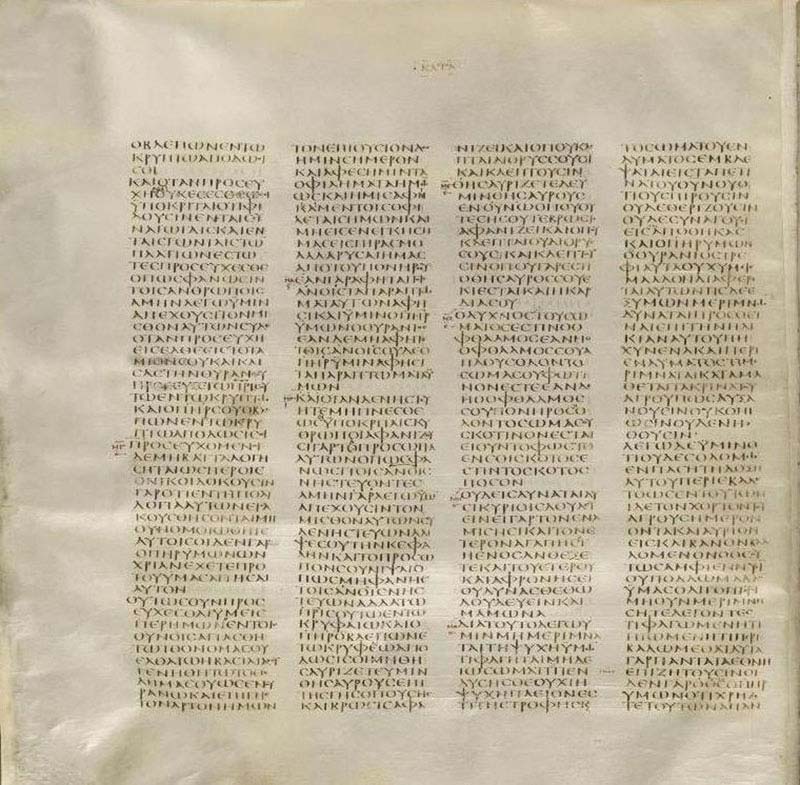 1844
1844Codex Sinaiticus Discovered
German scholar Constantin von Tischendorf discovered Codex Sinaiticus in the library of the Eastern Orthodox Saint Catherine’s Monastery on the Sinai Peninsula. After Codex Vaticanus, Codex Sinaiticus is considered the most important ancient Greek text of the New Testament. -
1870
English Revised Version
With criticism of the King James Version mounting, the Church of England authorized a new translation in 1870 and the English Revised Version was published in portions between 1881 and 1885. An American version was subsequently published in 1901, aptly named the American Standard Version. -
1881
Westcott and Hort Greek New Testament
The publication of Westcott and Hort’s The New Testament in the Original Greek, which relied on Codex Sinaiticus and Codex Vaticanus, marked a shift in biblical scholarship away from the main Greek manuscript, the Textus Receptus, used to produce the King James Version. -
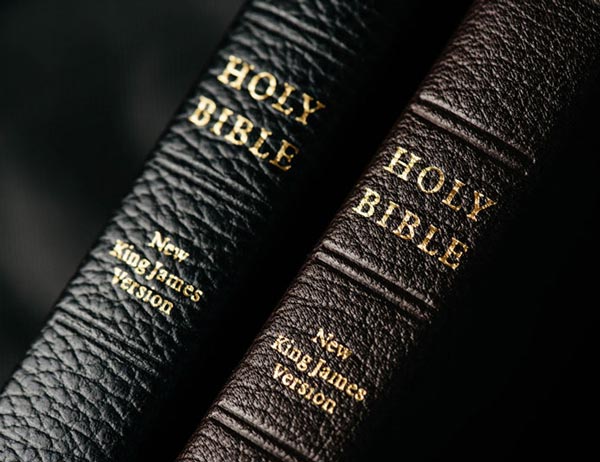 1982
1982New King James Version
Using the same manuscript evidence used by the King James Version, the New King James Version is an updated English translation of the KJV, the first since 1769. -
2012
Nestle-Aland Greek New Testament
First published in 1898, the Nestle-Aland Greek New Testament is now in its 28th edition (2012) and is the Greek text that all modern Bible translations are based upon, as most scholars prefer to use more recently discovered manuscripts. -
 2022
2022Search Engines
Over four hundred years after first being published, the King James Version remains popular and the most searched for version on Google today.
What’s the difference between Bible translations?
There are two main philosophies behind translating the Bible, and they range on a continuum between:
1
Word-for-Word
Adhering to the words and structure of the original language without sacrificing clarity.
2
Thought-for-Thought
Prioritizing clarity and understanding of the meaning of the original language without sacrificing accuracy.
- Interlinear Bible
Year Published: 2005
Distinctives: See the text from your KJV English translation seen alongside the original Greek and Hebrew, great for Bible teachers and scholars. - New American Standard Bible (NASB)
Year Published: Gospel of John (1960); New Testament (1963); Complete Bible (1971); Most recent revision (2020)
Distinctives: Widely considered the most accurate text for preaching and teaching, though not necessarily reading. - Amplified Bible (AMP)
Year Published: Gospel of John (1954); New Testament (1958); Complete Bible (1965) Most recent revision (2015)
Distinctives: Multiple word or idea meanings included within the text. Brings your study notes right into the passage. - English Standard Version (ESV)
Year Published: 2001; revisions 2011 and 2016
Distinctives: A more readable word-for-word translation than the NASB, but using more recently discovered manuscripts than the KJV. - Revised Standard Version (RSV)
Year Published: New Testament (1946); Complete Bible (1952); revision 1971
Distinctives: First to use newly discovered, more ancient manuscripts including the Dead Sea Scrolls’ Isaiah manuscript. A favorite of academics and scholars. - King James Version (KJV)
Year Published: 1611
Distinctives: The gold standard in translation for its time and for 400 years, poetic 17th century language is known worldwide. - New King James Version (NKJV)
Year Published: New Testament (1979); Psalms (1980); Complete Bible (1982)
Distinctives: Same manuscripts as the original KJV, but brings the language up-to-date with 20th century English. - Modern English Version (MEV)
Year Published: New Testament (2011); Complete Bible (2014)
Distinctives: Like the NKJV, uses the KJV and its manuscripts as a base, while bringing its English language all the way up to 21st century standards.
- Christian Standard Bible (CSB)
Year Published: Complete Bible (2017); updated 2020
Distinctives: Balances a literal translation with expression in modern, simplified language for maximized readability. - New Revised Standard Version (NRSV)
Year Published: Complete Bible (1989); Updated Edition (2021)
Distinctives: More thought-for thought than the RSV, and embraced by Roman Catholics, Greek Orthodox, as well as Jewish scholars for the Old Testament. - Evangelical Heritage Version (EHV)
Year Published: New Testament (2017); Complete Bible (2019)
Distinctives: Uses a unique mixture of manuscripts, every translator came from the Lutheran tradition. Extensive footnotes. - New English Translation (NET)
Year Published: Complete Bible (2001); latest revision (2019)
Distinctives: First online Bible, readable for the lay person, technical translator notes great for students and missionaries. - New American Bible Revised Edition (NABRE)
Year Published: Complete Bible (1986); latest revision (2011) Committee: 55 editors, consultants, and revisers - New International Version (NIV)
Year Published: New Testament (1973); Complete Bible (1978); Major Revisions (1984 and 2011)
Distinctives: First modern translation to achieve popular use since the King James Version, 10 year translation project. - International Standard Version (ISV)
Year Published: Electronic version (2011); Release 2.0 (2015)
Distinctives: Uses a digital-only format, with version numbers for updates, though difficult to find online. - GOD’S WORD Translation (GW)
Year Published: Complete Bible (1995); latest revision (2020)
Distinctives: It’s focus on easy reading make this translation great for ESL speakers and first-time Bible readers.
- New Century Version (NCV)
Year Published: New Testament (1983); Complete Bible (1987)
Distinctives: A revision of the International Children’s Bible (ICB), the language is purposefully simplified and gender-neutral. - New Living Translation (NLT)
Year Published: Complete Bible (1996); latest revision (2015)
Distinctives: An update to The Living Bible paraphrase that goes back to original manuscripts. Accuracy in clear natural English is the goal. - Common English Bible (CEB)
Year Published: New Testament (2010); Complete Bible (2011)
Distinctives: Produced by a wholly ecumenical team and used teenagers to read and test how well the text was understood. - Good News Bible (GNB)/Good News Translation (GNT)
Year Published: Complete Bible (1976); Second Edition (1992); GNT (2001)
Distinctives: The goal is easy-to-read Bibles, published as inexpensive paperbacks, easy to distribute, used by Billy Graham Association. - Easy-to-Read Version (ERV)
Year Published: 2006; 2015
Distinctives: Aiming for a 3rd-grade reading level, this Bible is the easiest to read version available today. - Contemporary English Version (CEV)
Year Published: New Testament (1991); Complete Bible (1995)
Distinctives: Aimed at both a lower reading level and no biblical literacy – criticisms say the paraphrase eliminates theological truth. - The Living Bible
Year Published: 1967 Living New Testament, 1971 The Living Bible, Paraphrased
Distinctives: Written by businessman Ken Taylor to put the Scripture in an understandable form for family Bible reading. - The Voice (VOICE)
Year Published: New Testament (2011); Complete Bible (2012)
Distinctives: The Voice has incorporated writers, poets, artists, and even musicians into its editorial team. Aim to “tell the story of Scripture.” - The Message (MSG)
Year Published: Portions of the Bible beginning (1993), Complete Bible (2002); Latest Revision (2018)
Distinctives: Recommended for use alongside your Word-for-Word translation. Many find The Message gives fresh inspiration on Scripture.

